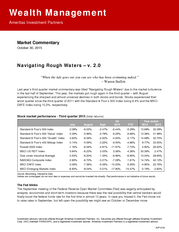Description
investment process.” Diversification, along with an investment roadmap in the form of well-defined objectives
and policies, takes the emotions out of the investment equation and typically has been the surest path to
financial success. While it’s easy to adhere to the investment plan when times are good, some investors find it
difficult to stay on the path when the road gets a bit rocky. It’s during times like these that detours tempt
investors. However, wandering off can take you into unfamiliar neighborhoods, and delays will cost you
precious time.
Our basic message still remains unchanged from the past several years.
We continue to advise an aboveaverage equity weight. Markets rise and markets fall, but unless there have been changes in your circumstances or you’ve hit milestones in your life, such as retirement, stay with the plan. For clients with an allocation to bonds, we continue to see value in U.S. Agency bonds with periodic “step-ups” in coupon rates and higher quality corporate and municipal issuers generally with maturities of 10 years or less.
We also have been seeing some value in Certificates of Deposit for clients with shorter-term investment horizons. We hope you’ve found this review to be educational and helpful. As always, we thank you for your support and welcome your comments. Source for all statistical data is Bloomberg unless otherwise noted. The performance data quoted represents past performance, which does not guarantee future performance.
This report has been prepared by Ameritas Investment Partners from original sources and data we believe to be reliable, but we make no representations as to their accuracy or completeness. This report is published solely for informational purposes and is not to be construed as an offer to sell or the solicitation of an offer to buy any security in any state where such an offer or solicitation would be illegal. Ameritas Investment Partners, Inc.
is a registered investment advisor. Ameritas, its affiliates and/or their officers and employees may from time to time acquire, hold or sell a position in the securities mentioned herein. Opinions expressed herein may differ from the opinions expressed by other divisions or affiliates of Ameritas Investment Partners. 390 N.
Cotner Boulevard / Lincoln, NE 68505 / P: 402-467-6970 .
We continue to advise an aboveaverage equity weight. Markets rise and markets fall, but unless there have been changes in your circumstances or you’ve hit milestones in your life, such as retirement, stay with the plan. For clients with an allocation to bonds, we continue to see value in U.S. Agency bonds with periodic “step-ups” in coupon rates and higher quality corporate and municipal issuers generally with maturities of 10 years or less.
We also have been seeing some value in Certificates of Deposit for clients with shorter-term investment horizons. We hope you’ve found this review to be educational and helpful. As always, we thank you for your support and welcome your comments. Source for all statistical data is Bloomberg unless otherwise noted. The performance data quoted represents past performance, which does not guarantee future performance.
This report has been prepared by Ameritas Investment Partners from original sources and data we believe to be reliable, but we make no representations as to their accuracy or completeness. This report is published solely for informational purposes and is not to be construed as an offer to sell or the solicitation of an offer to buy any security in any state where such an offer or solicitation would be illegal. Ameritas Investment Partners, Inc.
is a registered investment advisor. Ameritas, its affiliates and/or their officers and employees may from time to time acquire, hold or sell a position in the securities mentioned herein. Opinions expressed herein may differ from the opinions expressed by other divisions or affiliates of Ameritas Investment Partners. 390 N.
Cotner Boulevard / Lincoln, NE 68505 / P: 402-467-6970 .
Economic Conditions Sub Categories














